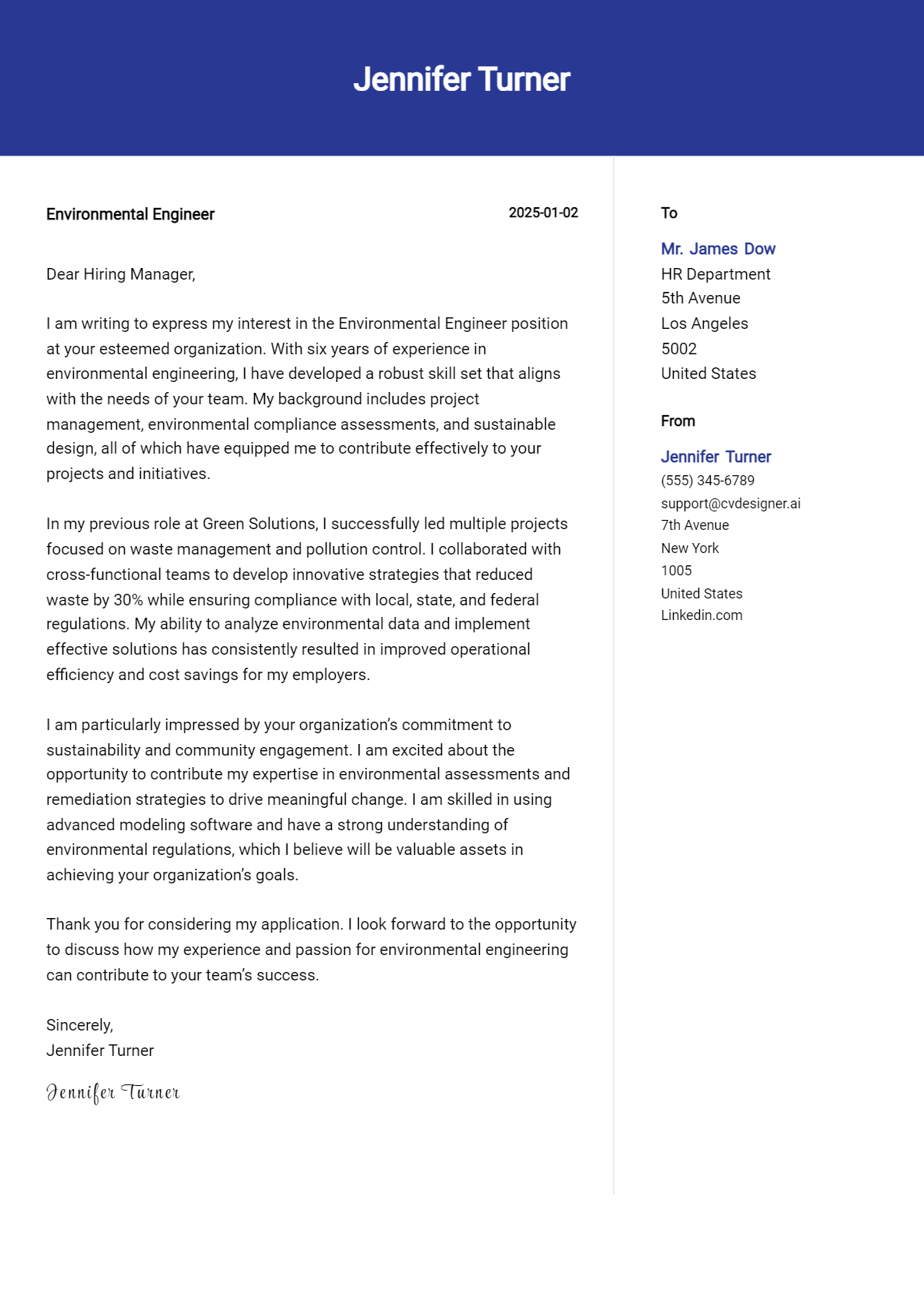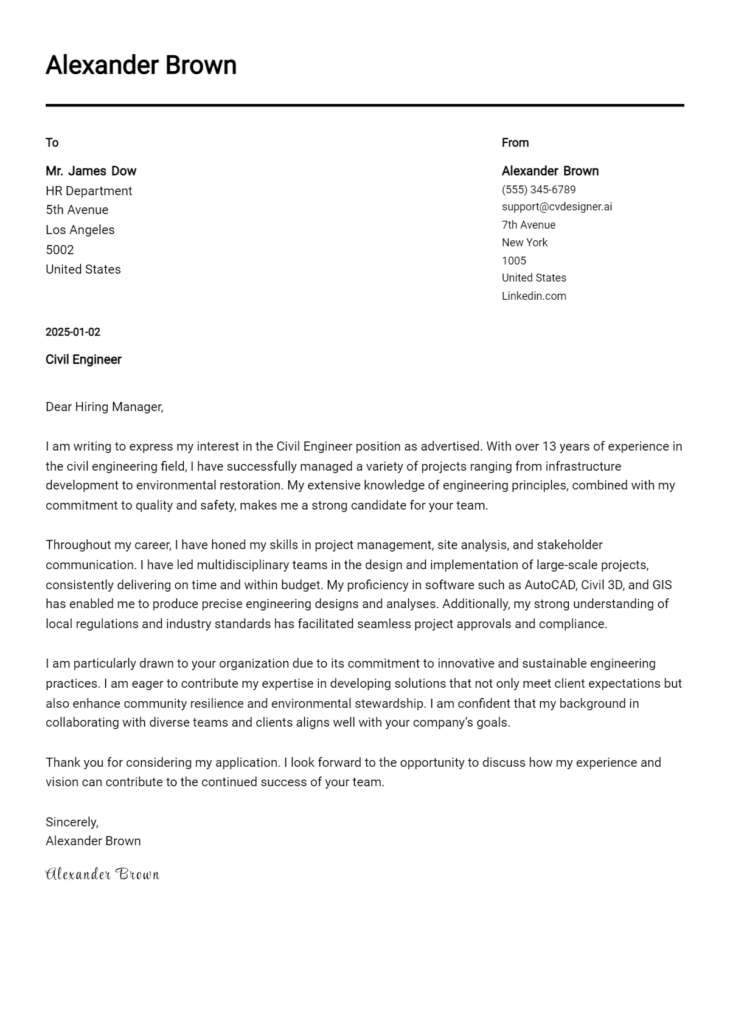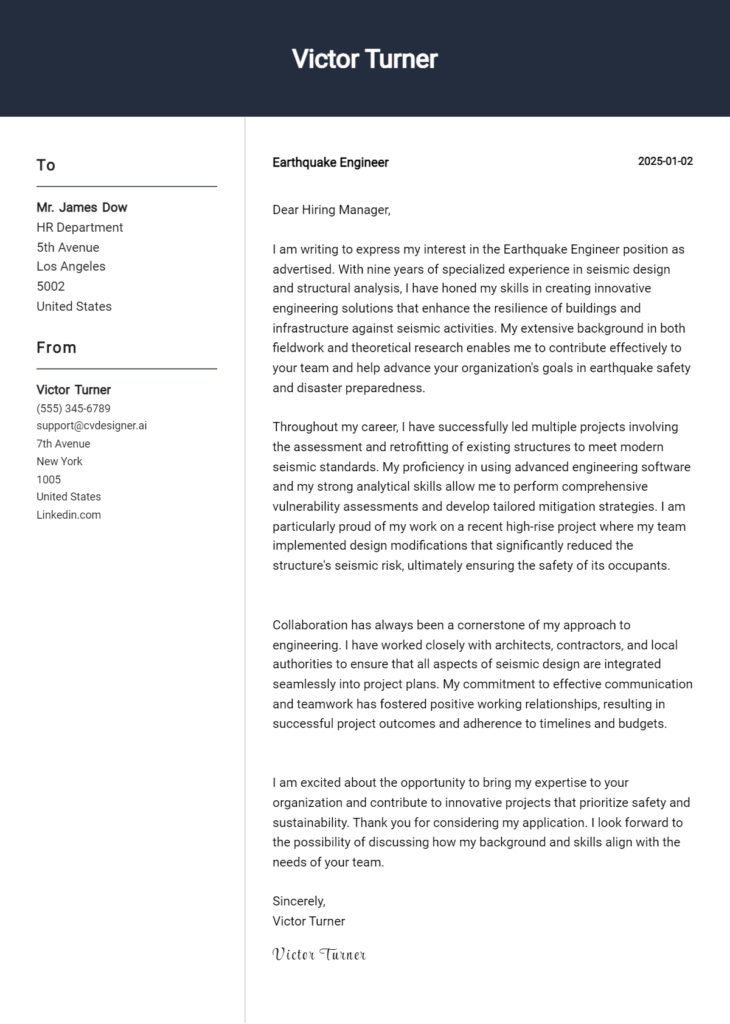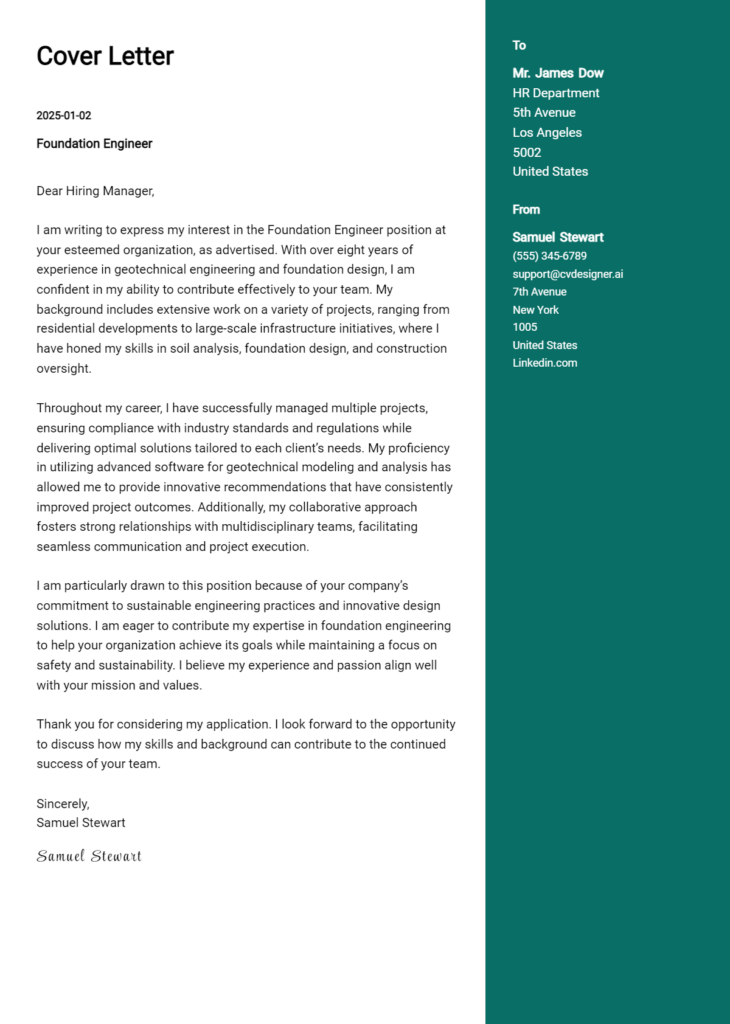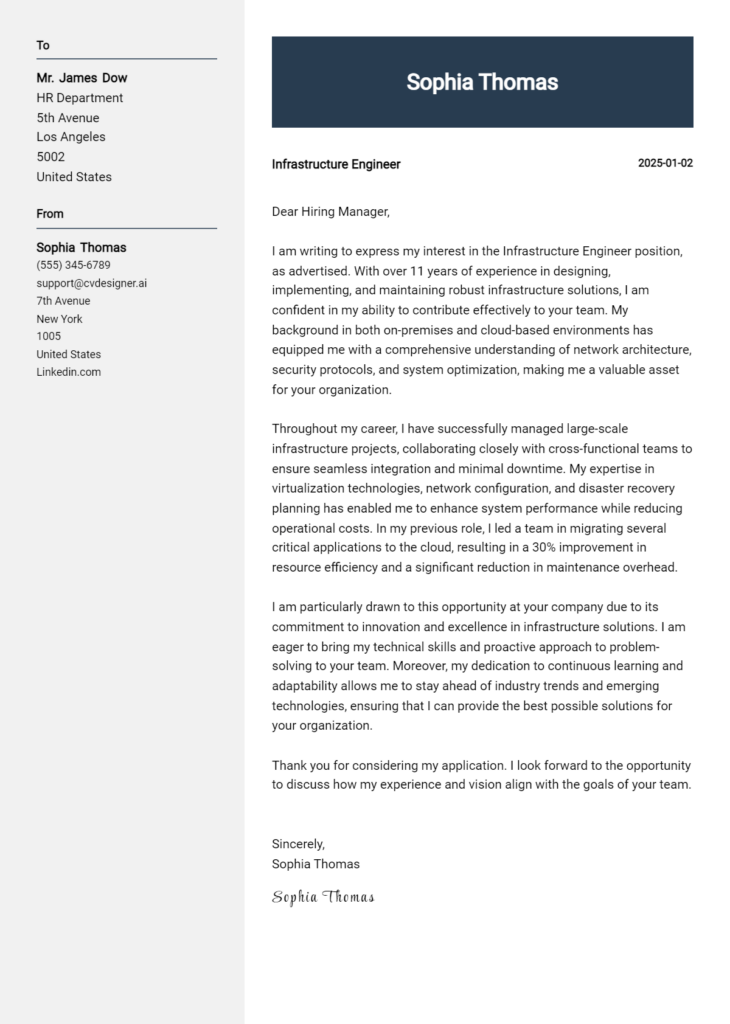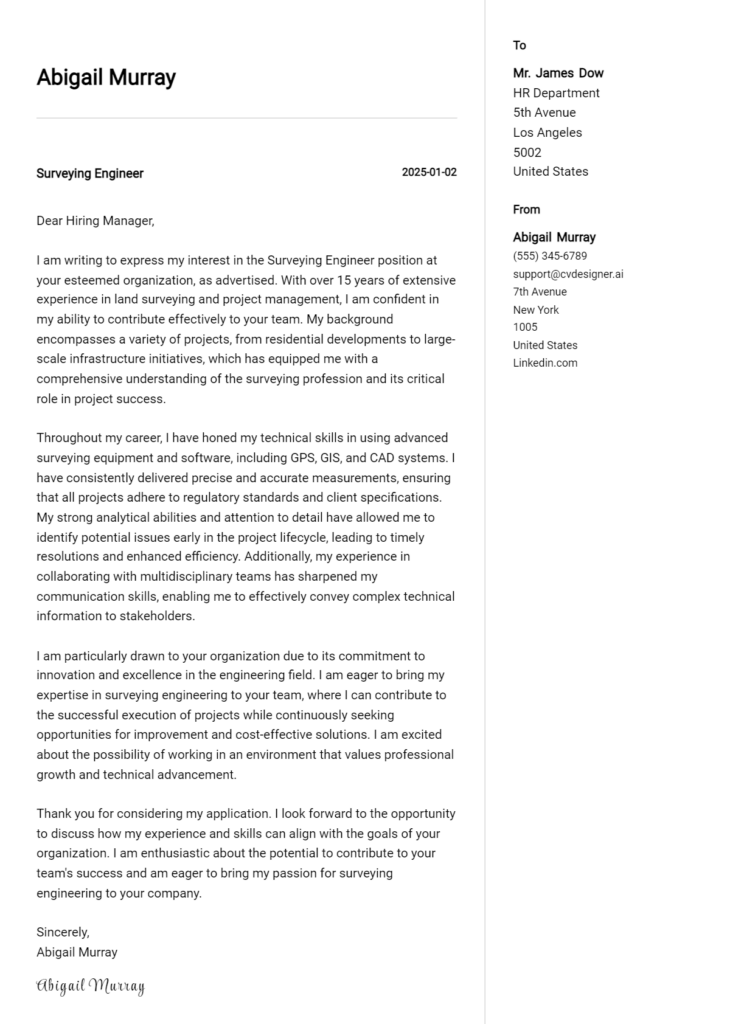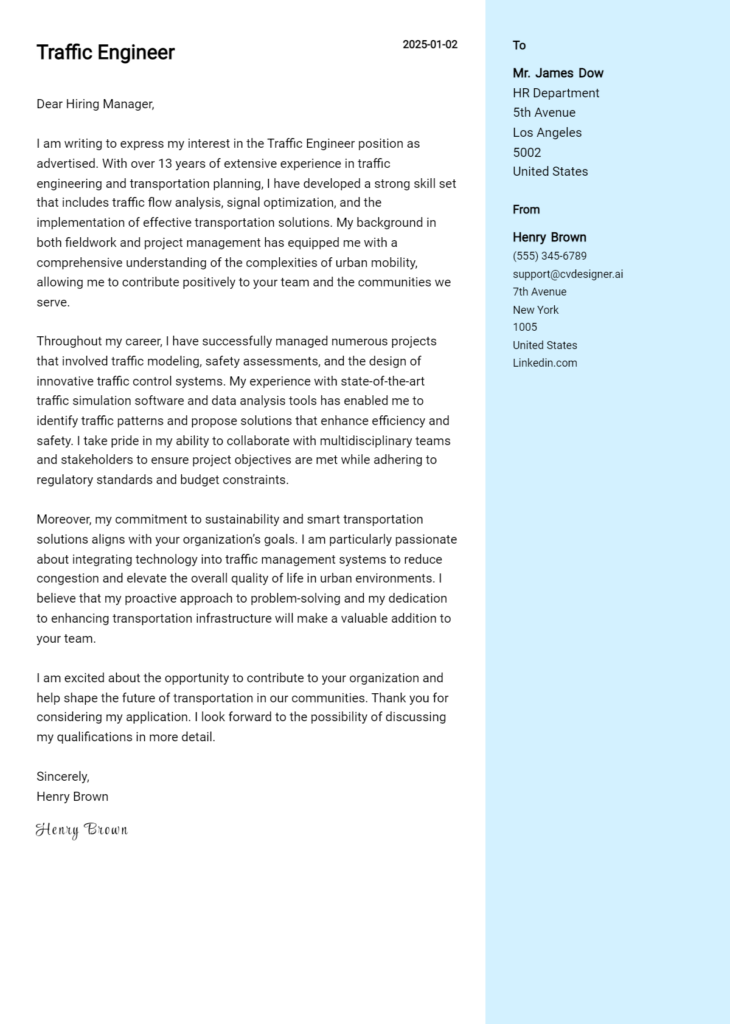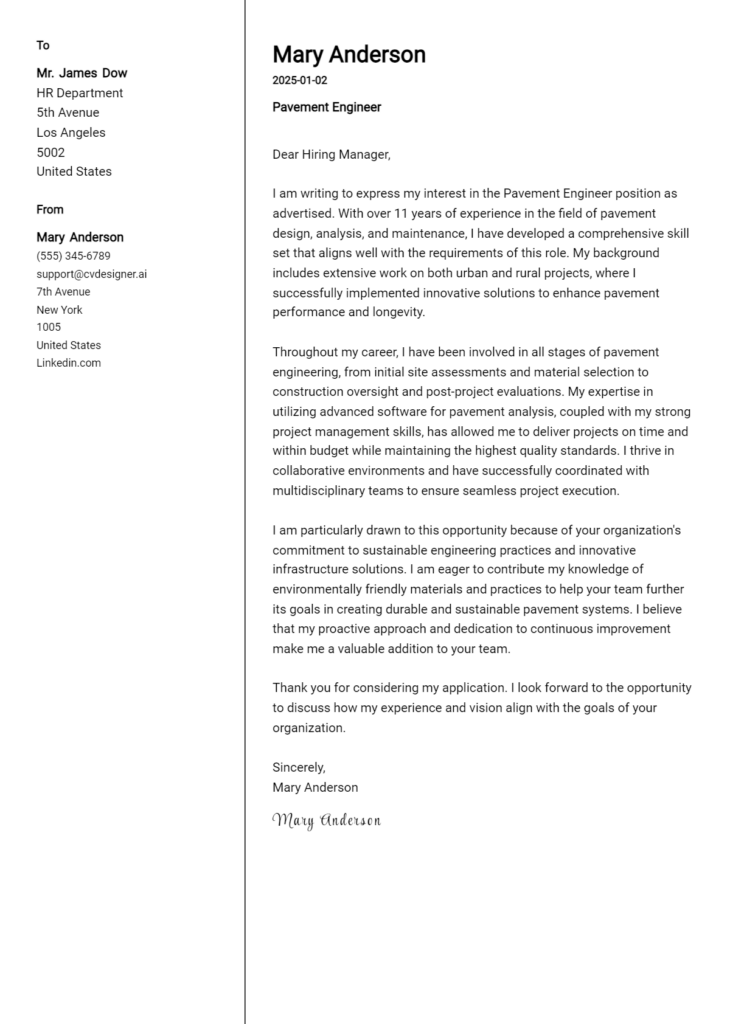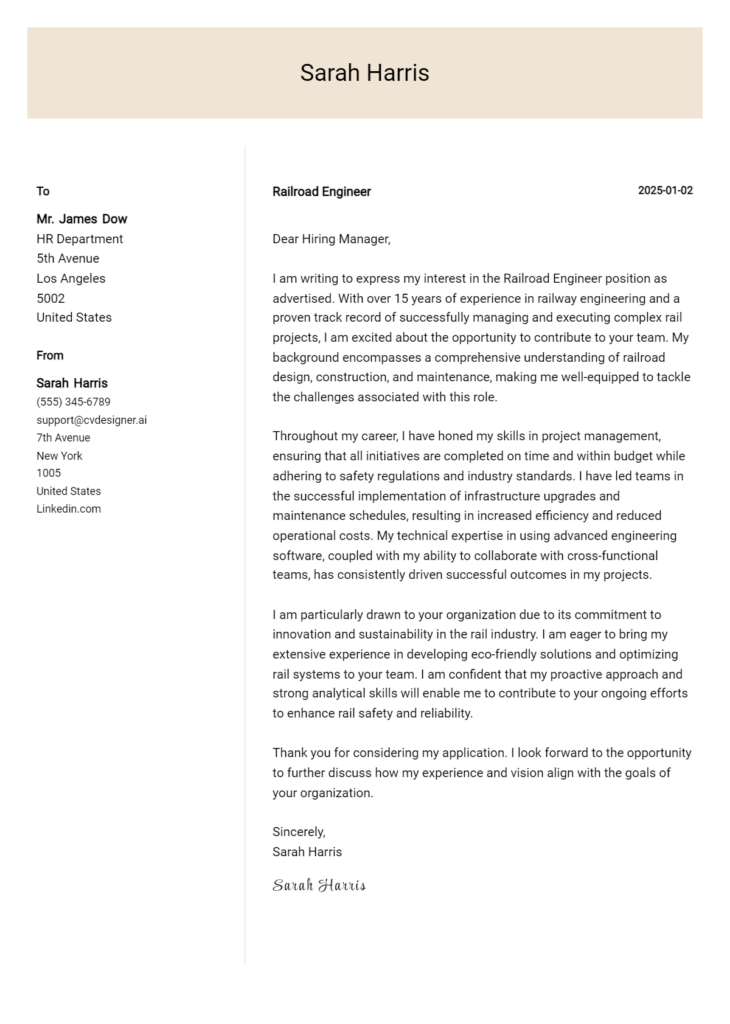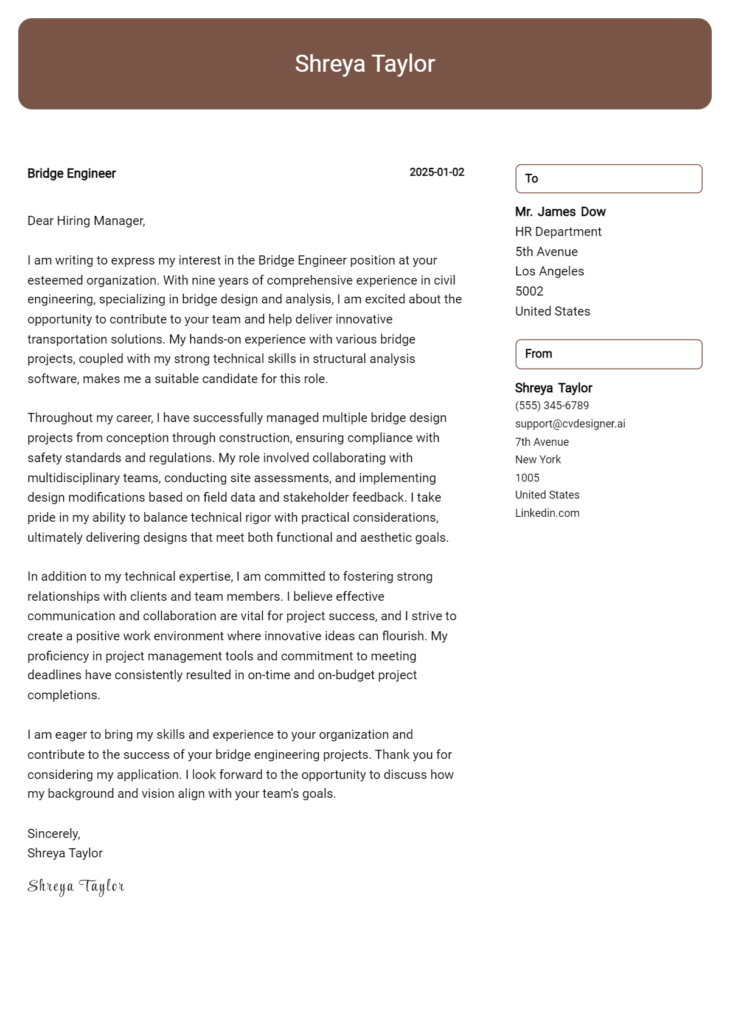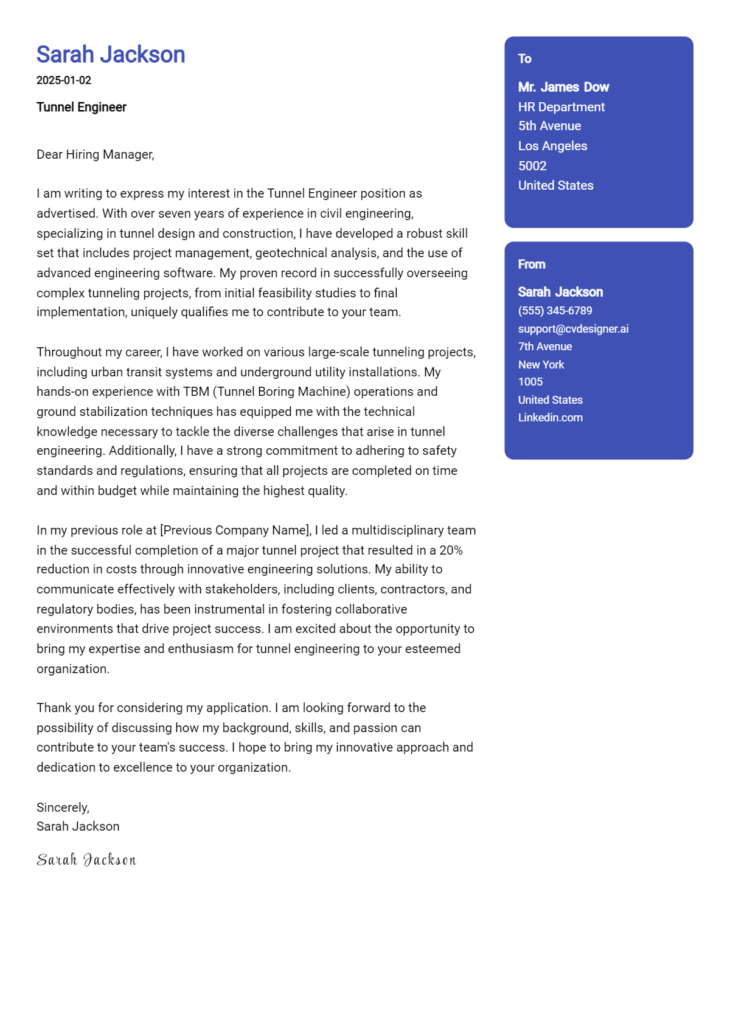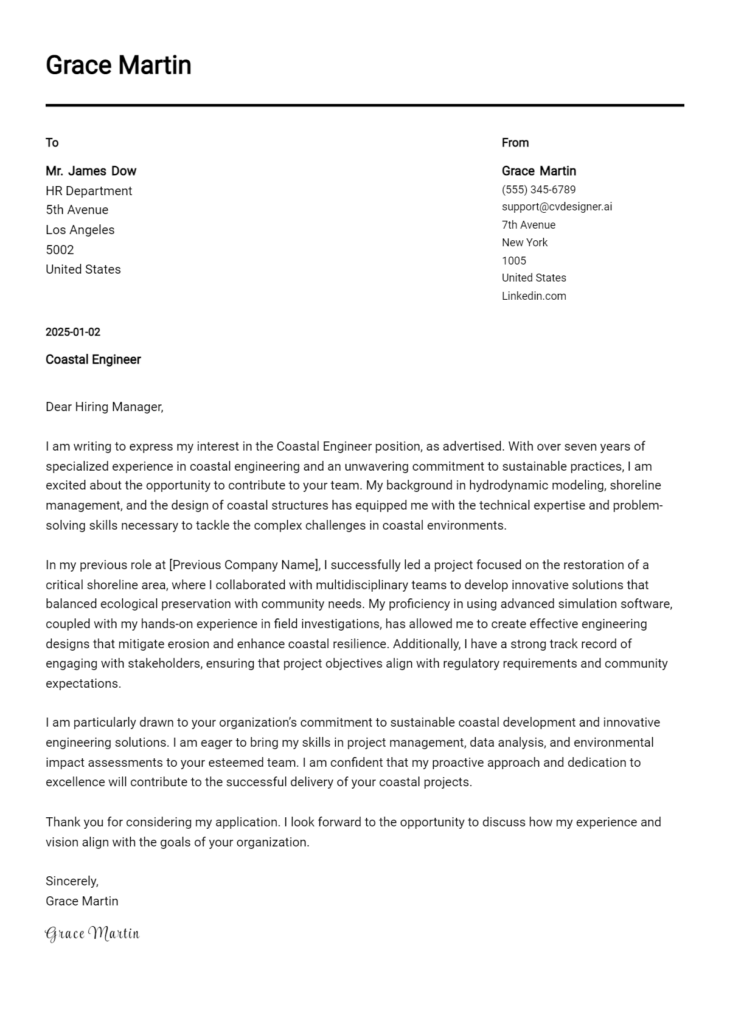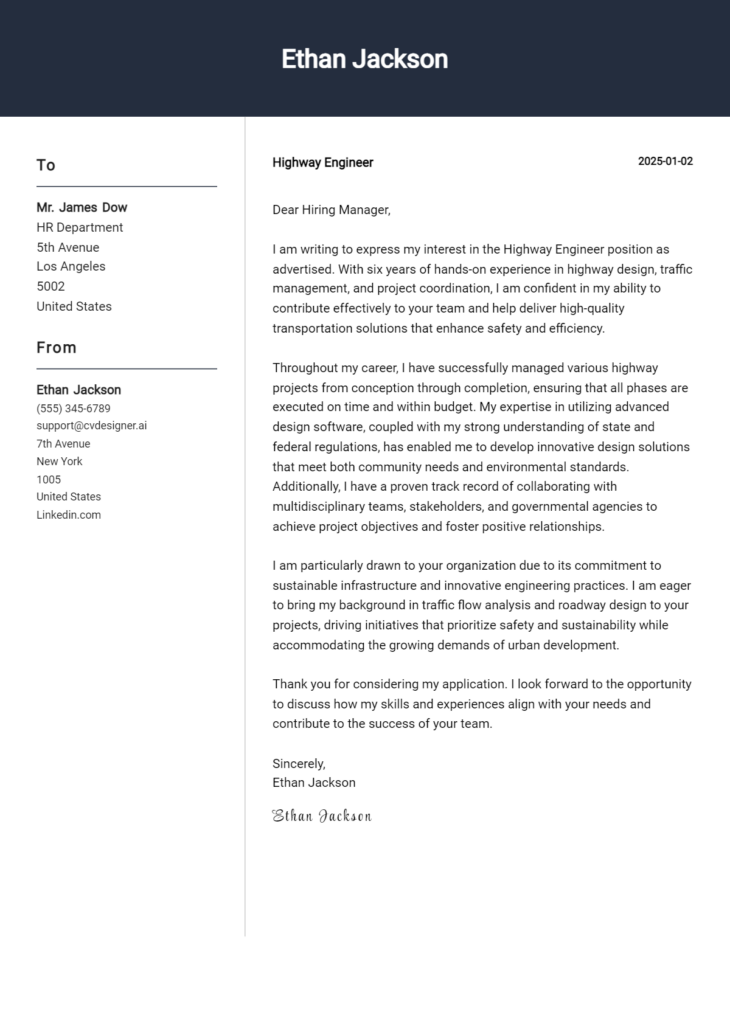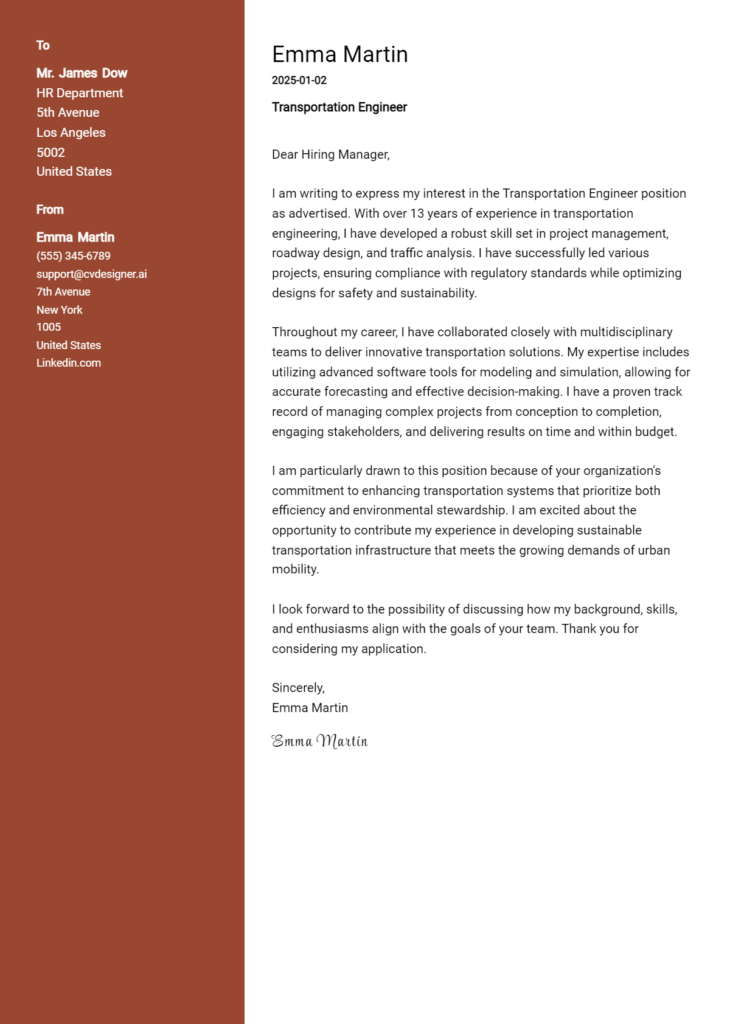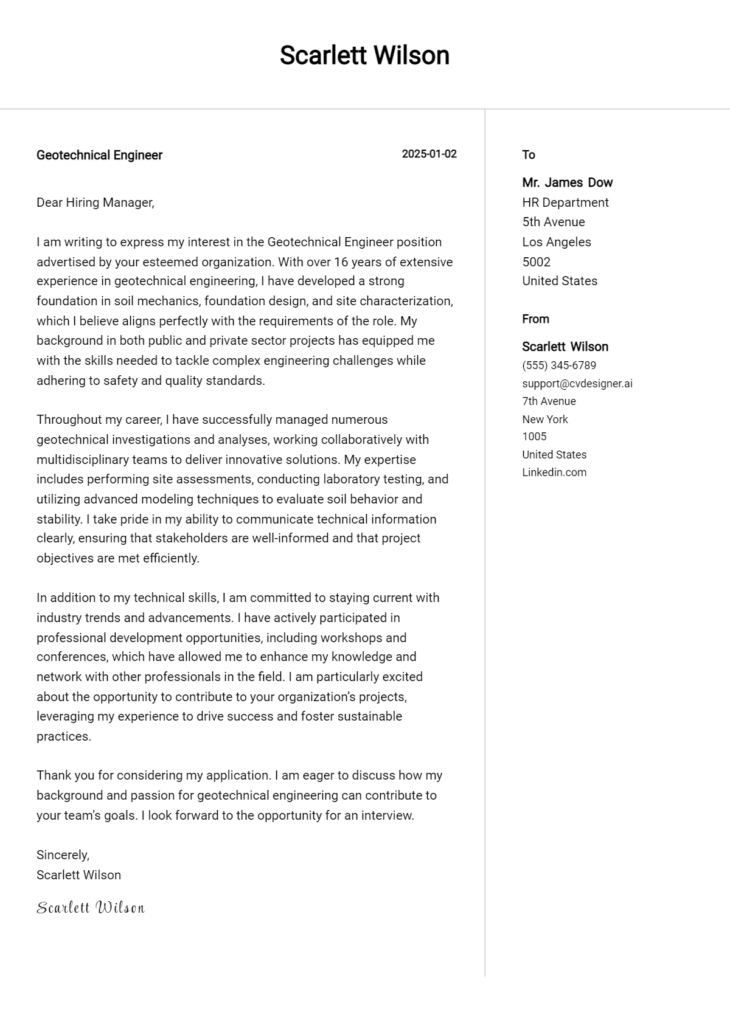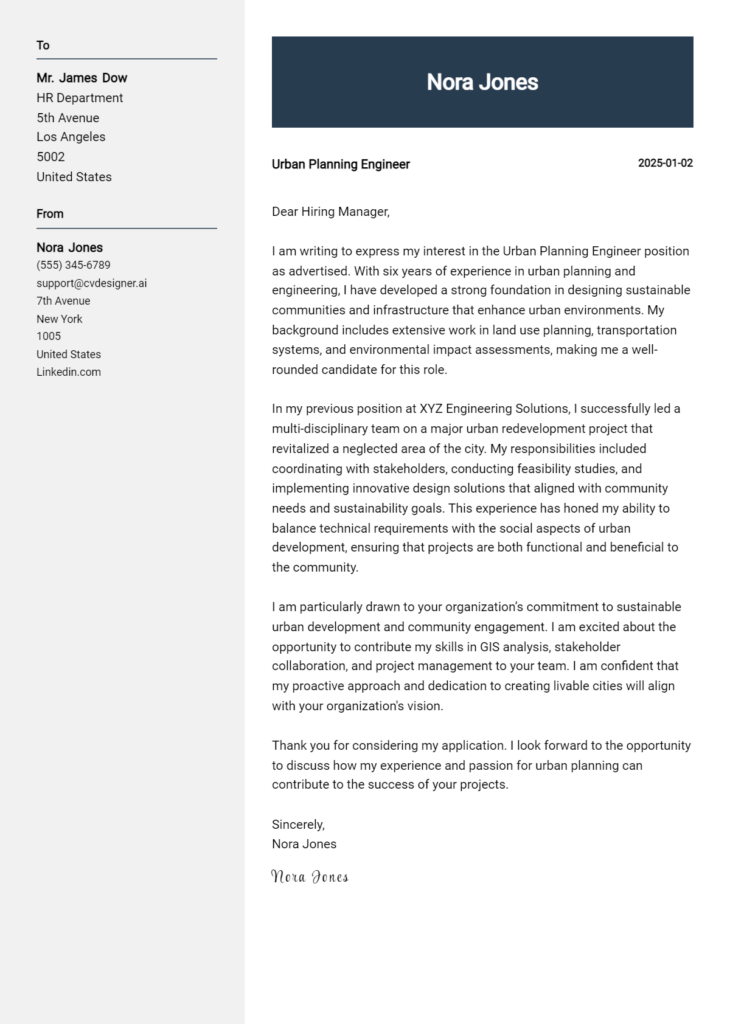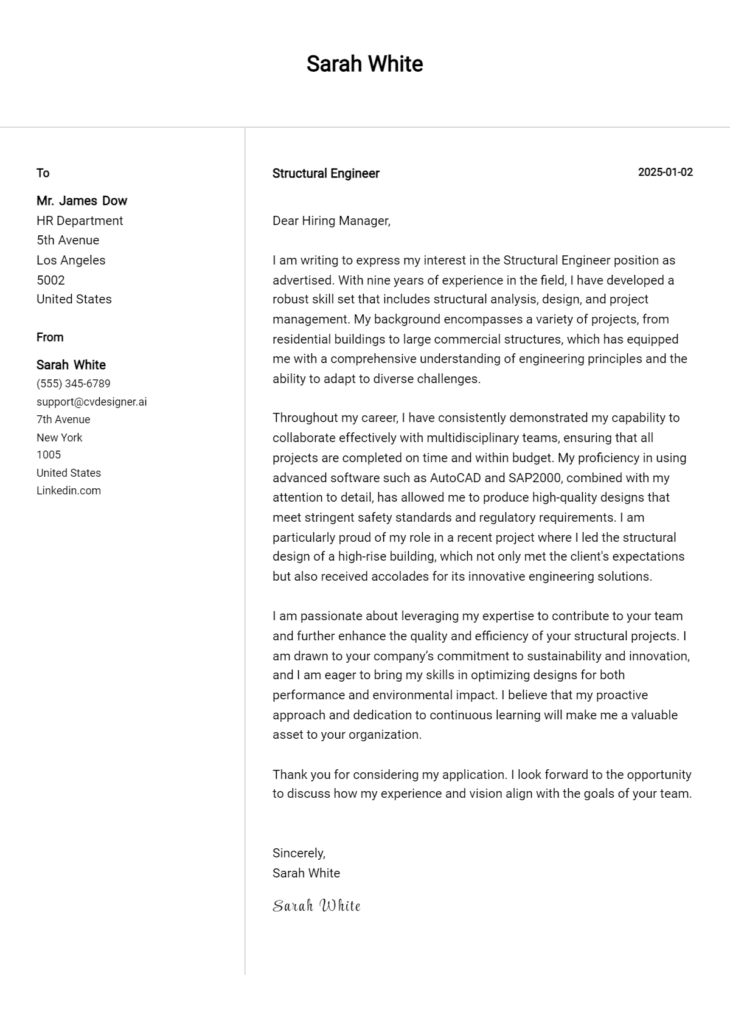Environmental Engineer Cover Letter Examples
Explore additional Environmental Engineer cover letter samples and guides and see what works for your level of experience or role.
How to Format an Environmental Engineer Cover Letter?
Crafting an effective cover letter is essential for environmental engineers, as it serves as your first opportunity to showcase your expertise and passion for sustainable practices. The way you format your cover letter not only reflects your professionalism but also demonstrates your commitment to environmental stewardship and attention to detail—qualities that are critical in this field. A well-structured cover letter can capture the hiring manager's attention, illustrating your ability to communicate complex ideas clearly and succinctly.
In this guide, we will explore how to structure your cover letter, offering valuable insights and examples specific to the environmental engineering profession.
We'll focus on the essential components of a professional cover letter, including:
- Cover Letter Header
- Cover Letter Greeting
- Cover Letter Introduction
- Cover Letter Body
- Cover Letter Closing
Each section is crucial for presenting your qualifications and showcasing your dedication to the environment. Let’s break down each part and explain how to make your environmental engineer cover letter stand out.
Importance of the Cover Letter Header for an Environmental Engineer
A well-crafted cover letter header is crucial for making a strong first impression as an Environmental Engineer. It serves as the first point of contact between you and your potential employer, setting the tone for the rest of your application. The header should contain essential information such as your contact details, the date, and the recipient's information. Clarity and professionalism are paramount, as they reflect your attention to detail and organizational skills—qualities that are vital in the field of environmental engineering.
A strong header clearly presents your information in a structured format, while a weak header may lack organization, making it difficult for the recipient to identify key details. Below are examples of both a strong and a weak cover letter header for an Environmental Engineer.
Strong Example
John Doe 123 Green Street Eco City, CA 98765 john.doe@email.com (123) 456-7890 [Date] Jane Smith Hiring Manager Environmental Solutions Inc. 456 Clean Way Eco City, CA 98765
Weak Example
Hey, This is John Doe. I live at 123 Green Street. Just wanted to apply for the job.
The Importance of a Strong Cover Letter Greeting for Environmental Engineers
The greeting of your cover letter is crucial as it sets the tone for the entire document and showcases your professionalism and attention to detail. A personalized greeting, where you address the hiring manager directly, not only demonstrates your enthusiasm for the position but also your effort to connect with the organization. Avoiding generic greetings like "To Whom It May Concern" can significantly enhance the impact of your introduction. If possible, take the time to research the name of the hiring manager or the person responsible for the recruitment process. This simple act can make your cover letter stand out in a competitive job market.
When crafting your greeting, consider the following tips:
- Look for the hiring manager's name on the company's website or LinkedIn.
- If the name is not available, try to find a title or department to address.
- Keep it professional and appropriate for the industry.
Below are examples of strong and weak greetings for an Environmental Engineer cover letter.
Strong Greeting Example
Dear Dr. Sarah Thompson,
Weak Greeting Example
To Whom It May Concern,
The Importance of a Strong Cover Letter Introduction for an Environmental Engineer
A well-crafted cover letter introduction is crucial for an Environmental Engineer, as it serves as the first impression to the hiring manager. This introduction should not only capture attention but also convey genuine interest in the role and the organization. Additionally, it should briefly highlight key skills or achievements that align with the job requirements. A strong introduction sets the tone for the rest of the letter and provides a compelling reason for the hiring manager to continue reading.
Strong Example
Dear [Hiring Manager's Name], As a passionate Environmental Engineer with over five years of experience in sustainable design and waste management, I am excited to apply for the Environmental Engineer position at [Company Name]. My recent project, which successfully reduced waste by 30% in collaboration with local businesses, reflects my commitment to creating innovative solutions that not only meet regulatory requirements but also promote environmental stewardship. I am eager to bring my expertise in environmental assessments and my collaborative approach to your esteemed team.
Weak Example
To whom it may concern, I am writing to apply for the Environmental Engineer position. I have a degree in Environmental Engineering and some experience in the field. I think I would be a good fit for your company and hope you consider my application.
Purpose of the Cover Letter Body for an Environmental Engineer
The cover letter body serves as a crucial component of the application process for an Environmental Engineer, as it is the candidate's opportunity to effectively convey their relevant skills, experiences, and the unique value they can bring to the organization. Within this section, candidates should highlight specific projects or accomplishments that demonstrate their expertise in environmental regulations, sustainability practices, and innovative engineering solutions. By providing detailed examples of past work, such as successful implementations of waste reduction strategies or involvement in large-scale remediation projects, applicants can illustrate their ability to contribute positively to the company’s goals and mission.
Strong Example
Dear Hiring Manager, I am excited to apply for the Environmental Engineer position at GreenTech Solutions. In my previous role at EcoDesign Corp, I led a team in the successful implementation of a comprehensive wastewater treatment project that reduced pollutants by 40% and increased operational efficiency by 30%. This project not only achieved compliance with state regulations but also resulted in significant cost savings for the company. Additionally, my work on a community-based recycling initiative engaged over 500 local residents, fostering sustainable practices and enhancing public awareness of environmental issues. I am eager to bring my expertise in environmental engineering and project management to GreenTech Solutions and contribute to your mission of creating a sustainable future. Sincerely, Jane Doe
Weak Example
Dear Hiring Manager, I am interested in the Environmental Engineer position at your company. I have worked on several projects, but I can't remember all the details. I believe I have the skills required for this job, and I am a hard worker. I am excited to help your company with its environmental goals. Best, John Smith
Importance of Cover Letter Closing for an Environmental Engineer
The closing paragraph of a cover letter is crucial for leaving a lasting impression on the hiring manager. It serves to summarize your qualifications, reiterate your enthusiasm for the role, and prompt the next steps in the hiring process, such as reviewing your resume or scheduling an interview. A strong closing conveys confidence and eagerness, while a weak closing can diminish the overall impact of your application.
Strong Example
Thank you for considering my application for the Environmental Engineer position at [Company Name]. With my extensive background in sustainable design and project management, coupled with my passion for environmental stewardship, I am excited about the opportunity to contribute to your team. I look forward to discussing how my skills can help [Company Name] achieve its sustainability goals. Please feel free to contact me to schedule an interview at your convenience.
Weak Example
Thanks for reading my cover letter. I think I might be a good fit for the job. If you want, you can look at my resume. Let me know if you want to talk.
Crafting an effective cover letter is crucial for candidates applying for an Environmental Engineer position. This document serves as a platform to showcase your technical skills, problem-solving abilities, and knowledge of the Software Development Life Cycle (SDLC), as well as your teamwork capabilities and passion for continuous learning. By highlighting these areas, you can make a compelling case for why you are the right fit for the job. Below are five detailed tips to help you create a standout cover letter.
Tips for Writing an Effective Environmental Engineer Cover Letter
Highlight Your Technical Skills
Clearly outline your relevant technical skills related to environmental engineering, such as knowledge of environmental regulations, proficiency in CAD software, or experience with environmental modeling tools. Use specific examples from your past work or projects to demonstrate these skills in action. This gives hiring managers a concrete understanding of what you bring to the table.Emphasize Problem-Solving Abilities
Environmental engineers often face complex challenges that require innovative solutions. Include anecdotes or examples that showcase your problem-solving skills. Describe a specific situation where you identified an environmental issue and the steps you took to resolve it. Quantify your results whenever possible to illustrate the impact of your solutions.Discuss Your Knowledge of the SDLC
If applicable, mention your familiarity with the Software Development Life Cycle (SDLC) and how it relates to your engineering projects. Explain how your understanding of this process has contributed to successful project outcomes, particularly in design and implementation phases. This demonstrates not only your technical expertise but also your ability to manage projects effectively.Showcase Teamwork and Collaboration
Environmental engineering often involves working in multidisciplinary teams. Highlight your experience collaborating with other professionals, such as scientists, project managers, and government officials. Discuss how your teamwork skills have led to successful project completions or improved environmental outcomes. This shows that you can work well with others and contribute positively to team dynamics.Express Your Passion for Continuous Learning
The field of environmental engineering is ever-evolving, and a commitment to continuous learning is essential. Mention any professional development courses, certifications, or workshops you've attended that relate to the field. Describe how these experiences have enhanced your skills and knowledge, and express your enthusiasm for staying updated on industry trends and innovations.
By incorporating these tips into your cover letter, you can effectively convey your qualifications and passion for the role of Environmental Engineer. If you need further assistance, consider using our cover letter templates or try our cover letter builder to create a polished and professional document.
Common Mistakes to Avoid in an Environmental Engineer Cover Letter
Crafting an effective cover letter is essential for standing out in the competitive field of environmental engineering. Avoiding common pitfalls can significantly enhance your chances of landing an interview. Here are some frequent mistakes to watch out for:
Generic Content: Using a one-size-fits-all approach can make your cover letter forgettable. Tailor your letter to the specific job and company by referencing relevant projects or values.
Neglecting the Format: A poorly formatted cover letter can detract from your professionalism. Ensure you follow a clear cover letter format that includes proper headings and spacing.
Excessive Length: Cover letters should be concise. Aim for a single page, focusing on your most relevant experiences and skills to keep the reader's attention.
Ignoring Keywords: Failing to include relevant keywords from the job description can lead to your application being overlooked. Highlight the specific skills and qualifications mentioned in the posting.
Lack of Enthusiasm: A cover letter that reads like a mere formality can signal disinterest. Infuse your writing with genuine passion for environmental engineering and the company’s mission.
Spelling and Grammar Errors: Simple mistakes can undermine your credibility. Always proofread your letter or use tools to check for errors before submission.
Not Showcasing Achievements: Merely listing responsibilities can be uninspiring. Instead, highlight your achievements and how they relate to the job at hand.
By avoiding these common mistakes, you can create a compelling cover letter that captures the attention of hiring managers. For more guidance, check out cover letter examples to inspire your writing.
Cover Letter FAQs for Environmental Engineer
What should I include in my cover letter for an Environmental Engineer position?
In your cover letter, you should include your relevant educational background, such as a degree in environmental engineering or a related field. Highlight specific experiences that demonstrate your skills, such as projects you've worked on or internships that provided hands-on experience with environmental assessments or sustainability initiatives. Mention any certifications relevant to the field, like LEED or EIT. Additionally, convey your passion for environmental issues and your commitment to sustainable solutions. Tailor your letter to the job description, emphasizing how your skills align with the responsibilities of the role. Finally, conclude with a call to action, expressing your eagerness to discuss your application further.
How can I make my cover letter stand out?
To make your cover letter stand out, personalize it for the specific position and company. Research the organization’s projects and values, and incorporate this knowledge to show your genuine interest. Use engaging language and a professional yet approachable tone. Instead of listing qualifications, demonstrate them through compelling stories that showcase your problem-solving skills and accomplishments, such as successful project completions or innovative solutions you’ve developed. Utilize metrics to quantify your impact where possible, like "reduced waste by 30% through a new recycling initiative." Lastly, ensure your layout is clean and professional, using clear headings and bullet points for easy reading.
How long should my cover letter be?
Your cover letter should ideally be one page long, consisting of three to four paragraphs. Aim for a word count between 250 to 400 words. This length allows you to succinctly convey your qualifications and enthusiasm without overwhelming the reader. Start with a strong opening paragraph that states your interest in the position and the organization. Follow this with one or two paragraphs detailing your relevant skills, experiences, and accomplishments. Finally, conclude with a brief summary of your interest and a call to action. Keeping it concise ensures that hiring managers will read the entire letter while still providing enough information to showcase your suitability for the role.
Should I address my cover letter to a specific person?
Yes, addressing your cover letter to a specific person is highly recommended. It shows that you've done your research and are genuinely interested in the role. If the job posting includes a hiring manager's name, use it. If not, you can often find this information on the company’s website or LinkedIn. If you're unable to find a specific name, a general greeting like “Dear Hiring Manager” is acceptable, but try to avoid generic phrases like “To Whom It May Concern.” A personalized greeting establishes a connection and makes your cover letter feel more tailored and thoughtful, which can leave a positive impression on the reader.
Build your Cover Letter in minutes
Use an AI-powered cover letter builder and have your letter done in 5 minutes. Just select your template and our software will guide you through the process.

